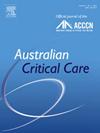成人重症监护病房动脉导管的流行和使用:一项澳大利亚和新西兰的流行研究
IF 2.7
3区 医学
Q2 CRITICAL CARE MEDICINE
引用次数: 0
摘要
背景材料导管(ACs)通常用于重症监护病房(icu)的监测和血液采样。优化空调护理需要更好地了解目前的使用和实践。目的本研究的目的是确定ICU患者使用AC的患病率,并描述当前的临床实践。方法作为乔治全球健康研究所和澳大利亚和新西兰重症监护学会临床试验组点流行计划的一部分,在澳大利亚和新西兰的icu中对≥16岁的患者进行了一项前瞻性、多中心、点流行研究。主要结局指标:主要结局指标为AC患病率。结果59例icu的924例患者中,有68.2%的患者发生ACs,主要发生在桡动脉(87.3%)和开放式换能器组(65.7%)。大多数医院是大都市医院(88.1%)和公立医院(84.7%)。患者平均年龄60.6岁(标准差:16.4),男性57.5%,急性生理和慢性健康评估(APACHE) II评分平均为17.7分(标准差:7.4)。39.8%的患者使用机械通气,34.3%的患者使用血管加压药物。大多数(93.0%)是首次入住ICU,主要来自急诊科(34.7%)或手术室(31.1%)。AC的存在与稍高的疾病严重程度评分相关,如APACHE II (Cohens d: 0.34; 95%可信区间[CI]: 0.20-0.48), ICU住院时间的适度增加(Cliff's Delta: 0.19; 95% CI: 0.11-0.27),机械通气的较高几率(优势比:5.13;95% CI: 3.64-7.24)和血管加压药的使用(优势比:7.70;95% CI: 5.09-11.64)。管理实践各不相同,每周(36.0%)、每4天(20.0%)或根据临床需要(20.0%)更换一次换药。大部分临床指征为AC切除(62.0%),20%的AC按时间间隔切除。结论icu中AC的高使用率突出了改进基于证据的实践指导的必要性,包括使用适应症、维持实践和移除。本文章由计算机程序翻译,如有差异,请以英文原文为准。
The prevalence and use of arterial catheters in adult intensive care units: An Australian and New Zealand point prevalence study
Background
Arterial catheters (ACs) are commonly used in intensive care units (ICUs) for monitoring and blood sampling. Optimising AC care requires a better understanding of current use and practices.
Objective
The objective of this study was to determine the prevalence of AC use in ICU patients and describe current clinical practices.
Methods
A prospective, multicentre, point prevalence study of patients aged ≥16 years was conducted across Australian and New Zealand ICUs as part of The George Institute for Global Health and Australian and New Zealand Intensive Care Society Clinical Trials Group Point Prevalence Program.
Main outcome measure
The primary outcome was AC prevalence.
Results
Of 924 patients from 59 ICUs, 68.2% had ACs, primarily in the radial artery (87.3%) with an open transducer set (65.7%). Most hospitals were metropolitan (88.1%) and publicly funded (84.7%). Patients had a mean age of 60.6 years (standard deviation: 16.4), 57.5% were male, and the mean Acute Physiology and Chronic Health Evaluation (APACHE) II score was 17.7 (standard deviation: 7.4). Mechanical ventilation was used for 39.8% of patients, and 34.3% received vasopressors. Most (93.0%) were first-time ICU admissions, mainly from emergency departments (34.7%) or operating theatres (31.1%). The presence of an AC was associated with a slightly higher illness severity score, as shown by APACHE II (Cohens d: 0.34; 95% confidence interval [CI]: 0.20–0.48), and a modest increase in ICU length of stay (Cliff's Delta: 0.19; 95% CI: 0.11–0.27), higher odds of mechanical ventilation (odds ratio: 5.13; 95% CI 3.64–7.24), and vasopressor use (odds ratio: 7.70; 95% CI: 5.09–11.64). Management practice varied, with dressing changes occurring weekly (36.0%), every 4 days (20.0%), or as clinically needed (20.0%). AC removal was mostly clinically indicated (62.0%), with 20% of ACs removed at time-based intervals.
Conclusion
The high prevalence of AC use in ICUs highlights the need for improved evidence-based guidance for practice, including indications for use, maintenance practice, and removal.
求助全文
通过发布文献求助,成功后即可免费获取论文全文。
去求助
来源期刊

Australian Critical Care
NURSING-NURSING
CiteScore
4.90
自引率
9.10%
发文量
148
审稿时长
>12 weeks
期刊介绍:
Australian Critical Care is the official journal of the Australian College of Critical Care Nurses (ACCCN). It is a bi-monthly peer-reviewed journal, providing clinically relevant research, reviews and articles of interest to the critical care community. Australian Critical Care publishes peer-reviewed scholarly papers that report research findings, research-based reviews, discussion papers and commentaries which are of interest to an international readership of critical care practitioners, educators, administrators and researchers. Interprofessional articles are welcomed.
 求助内容:
求助内容: 应助结果提醒方式:
应助结果提醒方式:


